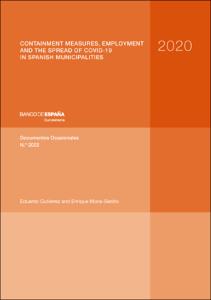Containment measures, employment and the spread of COVID-19 in Spanish municipalities
Autor
Fecha de publicación
25-ago-2020
Descripción física
20 p.
Resumen
Con el objetivo de contener el avance del Covid-19, el Real Decreto-ley 10/2020, del
29 de marzo, estableció el cese de toda actividad considerada como no esencial entre
el 30 de marzo y el 9 de abril de 2020, ambos inclusive. Este documento explota información
a escala municipal para cuantificar el impacto de corto plazo que ha tenido esta medida,
tanto sobre el empleo como sobre la contención de la pandemia. En concreto, el peso de
las actividades no esenciales en cada municipio se relaciona con la evolución de la afiliación
a la Seguridad Social y con los nuevos casos de Covid-19 diagnosticados a lo largo del
mes de abril. Los resultados sugieren que aquellos municipios más afectados por el cese
de las actividades no esenciales habrían sufrido mayores pérdidas de empleo, pero, a la
vez, habrían experimentado una propagación menos virulenta de la pandemia durante el
mes de abril. Finalmente, otras características, como una población más envejecida, unas
temperaturas más frías, una densidad de población más elevada o una mayor cercanía
a la capital de la provincia, también se asocian a una mayor incidencia del Covid-19 a
escala municipal.
In order to curb the advance of COVID-19, Royal Decree-Law 10/2020 of 29 March 2020 stipulated the temporary shutdown of all activities considered non-essential between 30 March and 9 April 2020. This paper uses municipal-level information to quantify the short-term effects of this measure both on employment and on containing the pandemic. Specifically, we analyse the relationship between the share of firms forced to shut down in each municipality and changes in Social Security registrations along with new COVID-19 cases in April. The results suggest that those municipalities most affected by the nonessential activity shutdown endured higher reductions in employment but, at the same time, they also witnessed a lower propagation of the pandemic during April. Finally, other characteristics such as ageing, colder temperatures, higher population density and proximity to the provincial capital are found to be associated with a higher incidence of COVID-19 at the municipality level.
In order to curb the advance of COVID-19, Royal Decree-Law 10/2020 of 29 March 2020 stipulated the temporary shutdown of all activities considered non-essential between 30 March and 9 April 2020. This paper uses municipal-level information to quantify the short-term effects of this measure both on employment and on containing the pandemic. Specifically, we analyse the relationship between the share of firms forced to shut down in each municipality and changes in Social Security registrations along with new COVID-19 cases in April. The results suggest that those municipalities most affected by the nonessential activity shutdown endured higher reductions in employment but, at the same time, they also witnessed a lower propagation of the pandemic during April. Finally, other characteristics such as ageing, colder temperatures, higher population density and proximity to the provincial capital are found to be associated with a higher incidence of COVID-19 at the municipality level.
Publicado en
Documentos Ocasionales / Banco de España, 2022
Otras versiones
Materias
Covid-19; Pandemia; Empleo; Municipios españoles; Pandemic; Employment; Spanish municipalities; Seguridad social y programas de asistencia social; Modelización econométrica; Mercado de trabajo; España
Aparece en las colecciones:












